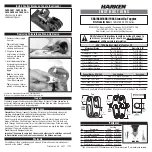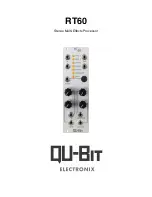
Triggering on a Sequence
TLS 216 User Manual
3–149
As Table 3–10 indicates, the time qualifier you choose determines the trigger
point. Depending on the time qualifier you choose, you can:
H
trigger as soon as possible after the logic scope recognizes the specified
sequence.
H
trigger after the logic scope recognizes the sequence relative to a time you
specify.
The two ways of triggering just listed reflect the following key concepts
governing sequence triggering with the logic scope.
H
The logic scope starts a timer when the start pattern compares TRUE. The
logic scope ignores the start pattern definition after starting the timer.
H
With all time qualifiers except the Time Out qualifier, the logic scope
triggers at the point the end pattern compares TRUE.
H
The Time Out qualifier is the exception; it triggers at the instant the timer
expires without the end pattern becoming TRUE.
To learn more about how your choices for time qualification affect the point at
which triggering occurs, read the procedures in the following list.
To Trigger on a Sequence, which begins on page 3–150, lists the basic procedure
to set up the logic scope to do a sequence trigger.
To Trigger Immediately on a Sequence, which begins on page 3–154, lists the
specialized procedure for using the time-limit qualifier > Time with minimum
time qualification to trigger as soon as possible on a sequence of two patterns.
Figure 3-70 on page 3–155 locates the trigger point for this type of time-
qualified sequence trigger.
To Trigger on a Time-Limit Qualified Sequence, which begins on page 3–155,
lists the more general procedure for using all three time-limit qualifi-
ers — < Time, > Time, and Time Out. It includes an example (Figure 3-71 on
page 3–156) that locates the trigger point for the Time Out qualified sequence
trigger and contrasts it with the trigger point established for other types of time
qualification follows the procedure.
To Trigger on a Time-Range Qualified sequence, which begins on page 3–157,
lists the general procedure for using both types of the time-range qualifiers, In
Range and Out of Range.
How Time Qualification
Affects the Trigger Point
Summary of Contents for P6240
Page 5: ......
Page 7: ......
Page 15: ...Table of Contents viii TLS 216 User Manual...
Page 20: ...Getting Started...
Page 26: ...Start Up 1 6 TLS 216 User Manual...
Page 51: ...Operating Basics...
Page 53: ...Overview 2 2 TLS 216 User Manual...
Page 73: ...Acquisition 2 22 TLS 216 User Manual...
Page 82: ...Reference...
Page 94: ...Adjusting the Vertical Setup 3 12 TLS 216 User Manual...
Page 104: ...Choosing an Acquisition Mode 3 22 TLS 216 User Manual...
Page 112: ...Choosing a Group Display Mode 3 30 TLS 216 User Manual...
Page 122: ...Customizing the Display 3 40 TLS 216 User Manual...
Page 130: ...Customizing the Display Colors 3 48 TLS 216 User Manual...
Page 162: ...Measuring Waveforms Automatically 3 80 TLS 216 User Manual...
Page 168: ...Measuring Waveforms with Cursors 3 86 TLS 216 User Manual...
Page 178: ...Printing a Hardcopy 3 96 TLS 216 User Manual...
Page 186: ...Probing of Circuits 3 104 TLS 216 User Manual...
Page 198: ...Saving and Recalling Waveforms 3 116 TLS 216 User Manual...
Page 222: ...Triggering on Patterns 3 140 TLS 216 User Manual...
Page 252: ...Triggering on States 3 170 TLS 216 User Manual...
Page 256: ...Viewing Status 3 174 TLS 216 User Manual...
Page 261: ...Appendices...
Page 283: ...Appendix B Algorithms B 18 TLS 216 User Manual...
Page 285: ...Appendix C Packaging for Shipment C 2 TLS 216 User Manual...
Page 290: ...Glossary...
Page 302: ...Glossary Glossary 12 TLS 216 User Manual...
Page 303: ...Index...
Page 319: ...Index Index 16 TLS 216 User Manual...
Page 320: ......
Page 321: ......
















































